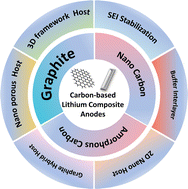Strategies and challenges of carbon materials in the practical applications of lithium metal anode: a review
Abstract
Lithium (Li) metal is strongly considered to be the ultimate anode for next-generation high-energy-density rechargeable batteries due to its lowest electrochemical potential and highest specific capacity. However, Li metal anode has limitations, involving inevitable dendritic Li growth, nonuniform Li deposition, enormous volume expansion, and ultimate electrode pulverization, which lead to rapid decrease in Coulombic efficiency and short circuits, significantly hindering its practical use. Various strategies have been proposed to solve uncontrollable dendritic Li growth and parasitic electrochemical reactions. Carbon materials and their composites with excellent structure tunability and properties have been explored to solve these issues and have shown great potential applications in Li metal anodes. This review presents various protective strategies of Li metal anode based on carbon materials. The rational design of carbon materials with specific functionalities in Li metal anode protecting solutions and manufacturing methods of composite electrodes with metallic Li and carbon materials are discussed in detail. In addition, a comprehensive understanding of the challenges and our outlook on the future development of carbon materials for stabilizing Li metal anodes in practical applications are discussed and prospected.

- This article is part of the themed collections: 2022 PCCP HOT Articles and PCCP Reviews


 Please wait while we load your content...
Please wait while we load your content...